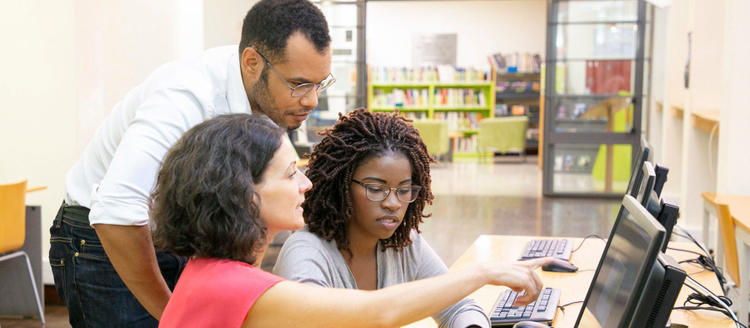How Refining Definitions of Digital Literacy Emphasizes Student Needs
Fracturing digital literacy.

One of the great things that emerged simultaneously with the development of Adobe’s Creative Cloud tools and the Adobe Creative Campus program is an invigorating conversation about digital literacy. The term has become a buzzword across not just U.S. campuses, but as part of global conversations regarding contemporary educational needs.
At my university, our provost has identified digital literacy as a fundamental “moonshot” concept and provides funding to developing digital literacy initiatives. Yet he has also articulated that digital literacy remains an ambiguous term and is reluctant to claim that digital literacy is necessary for all students.
He is, of course, not unique in pointing out this ambiguity, as digital literacy tends to be applied as an umbrella term for many different kinds of literacies. Digital literacy programs can include things like coding literacy, computational literacy, information literacy, media literacy, visual literacy, internet literacy, computer literacy, and so on.
I’d like to suggest that we adjust our thinking about digital literacy a bit. Perhaps we now need to acknowledge the complexity of digital literacy and expand our definitions to account for varying degrees of proficiency, fluency, competency, and literacy to the end of addressing student needs.
Consider, for example, the student working in the social sciences who needs to produce a poster. This student does not need to know how to code in Python or R or even HTML in order to successfully produce the poster. However, he or she is likely to need to know how to navigate a design application like Adobe InDesign and have a degree of understanding of the following things: poster as a genre, design principles like typography, visual rhetoric, content, and the material transition from the design application environment to a print-based delivery.
A computer science student, on the other hand, who has been assigned the task of coding a rudimentary image editor will require an entirely different set of skills tied to algorithms, coding languages, and application design, not to mention image technologies and even visual rhetoric. That is to say, we might now need to consider that not all students need full literacy in order to produce media and documents as part of their academic, professional, civic, or personal lives.
Thus, the question becomes, do all of our students need to be digitally literate, or are there students for whom a degree of familiarity might suffice? I offer that as educators and curriculum developers we now begin to be a bit more specific in what we mean by digital literacy and embrace a fractured definition that encompasses proficiency, fluency, and competency. To oversimplify, these terms might be considered as tiers within the more encompassing digital literacy platform.
Digital competency
We might think of digital competency as a kind of fundamental grounding in digital environments. The digitally competent student has an awareness that digital environments are constructed through program and code, but the student does not necessarily have the skills to code or program. Rather, digital competency identifies the ability to successfully complete a digital task like sending an email or creating the conference poster I noted before.
Competency, though, is more than just being able to complete a task — it requires a degree of theoretical understanding, of transferability, of being able to adapt skills and contexts. It provides us with a way of talking about blending skills and theory, the how and the why. Within the digital literacy framework, digital competency should be thought of as having the fundamentals — not illiterate, but not an expert.
Digital proficiency
We might understand digital proficiency as a stage of learning in which students are not just able to complete a task, but to do so with a more significant understanding of the process in which she or he engages. Borrowing from the methodologies of language proficiency, we can say that someone who is digitally proficient has a greater comprehension of the digital process as well as the ability to transfer a range of digital skills between contexts. Likewise, the digitally proficient student is able to use digital skills to make informed assumptions about other digital activities in order to adapt to other digital platforms and contexts.
For example, a student who is digitally proficient and regularly uses Adobe Photoshop has developed a proficiency that allows her to make assumptions about how to use Adobe Premiere Rush. Concurrently, she understands how to seek out tools that either fulfill the immediate need or understands how to locate the tools needed to learn how to learn an unfamiliar digital process. Reductively, digital proficiency suggests more than a rudimentary grasp of digital environments and processes, but it does not imply fluency.
Digital fluency
Reductively, we can think of fluency as suggesting expertise. Yet, fluency does not encompass the full range of digital literacy because it supposes expertise in a selected subset of skills. For example, a student might be an expert in using Premiere Pro to produce professional-caliber videos, but does not have slightest idea how to use Bootstrap libraries to build CSS frameworks for a mobile website. This student, then, is digitally fluent, certainly, if not digitally literate in a given arena.
Fracturing digital literacy initiatives to better fit student needs
The question that emerges, then, is one of the nature of digital literacy as an umbrella term and echoes the question our provost offered: Do all students need to be digitally literate, or are degrees of competency, proficiency, and fluency more applicable to our educational objectives?
I contend that digital literacy objectives might be more readily integrated into programmatic curricula by customizing competency, proficiency, and fluency approaches to specific disciplinary needs rather than attempting to build wholesale digital literacy components into general education efforts or cross-campus requirements that homogenize student subjects. That is to say, perhaps we should fracture our digital literacy initiatives in order to develop student learning outcomes that account for the digital environments in which individual students will interact.